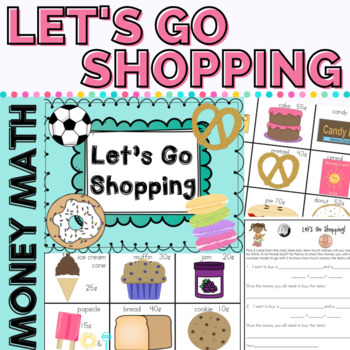Money Math Game | Center Activity Let's Go Shopping | Counting Coins | 1st Grade
- PDF
What educators are saying
Description
If you are looking for a fun way to reinforce counting coins and adding money, Let’s Go Shopping is a fun and motivating way to practice these skills. Using money, identifying coin values, counting money and adding money are important life skills.
This activity can be used in a math station or center to reinforce and build the concept of money. It is easy to understand and once taught can be used independently as a math rotation or for early finishers. Let's get those kids shopping!
⭐️ ⭐️ PLEASE SEE PREVIEW FOR MORE DETAILS ⭐️ ⭐️
Directions for Use:
♥ Students choose 2 cards that have items with money values to buy,
♥ They write the 2 items they want to buy in the spaces provided, add up the amount of money they will need to purchase the items and then show the money they will need by using P for penny, N for nickel , D for dime and Q for quarter.
What’s Included:
♥ 4 pages that can be run off back to back for children to demonstrate their knowledge of money and show their work. One set in Color and another in Black and White
♥ 36 cards with items that can be “purchased” in the class store with money amounts. These cards can be separated and differentiated to be used according student needs.
♥ 36 item cards without prices so you can write prices according to the needs of your class.
♥ 2 posters or signs that can be used for the front of a basket or box to hold merchandise to be purchased.
********************************************************************
Thank you for purchasing, downloading, browsing, following and inspiring! I hope this brings a bit of sunshine your way! If you find anything in this packet that needs to be reworked or might work better for your students, please let me know and I will be happy to rework any activity/packet that you have purchased to fit your needs.
Let's Connect
Blog: Joys Sunshine and Lollipops
IG: Joy's Sunshine and Lollipops
Pinterest: Sunshine and Lollipops
FEEDBACK
I appreciate feedback It helps me decide which products are most helpful and valuable for your students. I Love to create so if there is anything that you might need or want to make your job easier, just let me know!
To Earn Credit for Future Purchases,
Go to My Purchases page (you may need to login). Beside each purchase you'll see a Provide Feedback Link. Simply click it and you will be taken to a page where you can give a quick rating and leave a short comment for the resource. Each time you give feedback, you receive feedback credits that you can use to lower the cost of your future purchases
If you would like to be the first to know about my new discounts, freebies and product launches, click the GREEN STAR next to my shop logo on my main page and you will become a follower. This “easy peasy” action will now send you email updates about this store. If you have any questions, be sure to contact me!
Enjoy! Kathy





